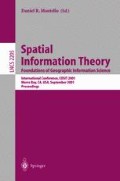Abstract
Despite extensive interest in the role of frames of reference in spatial representation, there is little consensus regarding the cognitive effort associated with various reference systems and the cognitive costs (if any) involved in switching from one frame of reference to another. Relevant to these issues an experiment was conducted in which accuracy and response latency data were collected in a task in which observers verified the direction of turns made by a model car in a mock city in terms of four different spatial frames of reference: fixed-observer (relative-egocentric), fixed-environmental object (intrinsic-fixed), mobile object (intrinsic-mobile), and cardinal directions (absolute-global). Results showed that frames of reference could be differentiated on the basis of response accuracy and latency. In addition, no cognitive costs were observed in terms of accuracy or latency when the frames of reference switched between fixed-observer vs. global frames of reference or between mobile object and fixed environmental object frames of reference. Instead, a distinct performance advantage was observed when frames of reference were changed. This unexpected result is attributed to a phenomenon analogous to release from proactive inhibition.
Access this chapter
Tax calculation will be finalised at checkout
Purchases are for personal use only
Preview
Unable to display preview. Download preview PDF.
References
Acredolo, L. P. (1976). Frames of reference used by children for orientation in unfamiliar spaces. In G. Moore & R. Golledge (Eds.), Environmental Knowing (pp. 165–172). Stroudsburg, PA: Dowden, Hutchinson, & Ross.
Acredolo, L. P. (1990). Behavioral approaches to spatial orientation in infancy. In A. Diamond (Ed.), The development and neural bases of higher cognitive function (pp. 596–607). New York: New York Academy of Sciences.
Allen, G. L. (1999). Children’s control of reference systems in spatial tasks: Foundations of spatial cognitive skill? Spatial Cognition and Computation, 1, 413–429.
Bremner, G. J. (1978). Egocentric versus allocentric spatial coding in nine-monthold infants: Factors influencing the choice of code. Developmental Psychology, 14, 346–355.
Bremner, G. J., Knowles, L., & Andreasen, G. (1994). Processes underlying young children’s spatial orientation during movement. Journal of Experimental Child Psychology, 57, 355–376.
Bryant, D. J. & Tversky, B. (1999). Mental representations of perspective and spatial relations from diagrams and models. Journal of Experimental Psychology: Learning, Memory, and Cognition, 25, 137–156.
Carlson-Radvansky, L. A. & Jiang, Y. (1998). Inhibition accompanies reference-frame selection. Psychological Science, 9, 386–391.
Cornell, E. H., & Heth, C. D. (1979). Response versus place learning by human infants. Journal of Experimental Psychology: Human Learning and Memory, 5, 188–196.
Frank, A. U. (1998). Formal models for cognition-Taxonomy of spatial location description and frames of reference. In C. Freksa, C. Habel, & K. F. Wender (Eds.), Spatial cognition: An interdisciplinary approach to representing and processing spatial knowledge (pp. 293–312). Berlin: Springer-Verlag.
Franklin, N., Tversky, B., & Coon, V. (1992). Switching points of view in spatial mental models. Memory and Cognition, 20, 507–518.
Heth, C. D., & Cornell, E. H. (1980). Three experiences affecting spatial discrimination learning by ambulatory children. Journal of Experimental Child Psychology, 30, 246–264.
Klatsky, R. L. (1998). Allocentric and egocentric spatial representations: Definitions, distinctions, and interconnections. In C. Freksa, C. Habel, & K. F. Wender (Eds.), Spatial cognition: An interdisciplinary approach to representing and processing spatial knowledge (pp. 1–17). Berlin: Springer-Verlag.
Levelt, W. J. M. (1996). Perspective taking ellipsis in spatial descriptions. In P. Bloom, M. A. Peterson, L. Nadel, & M. F. Garrett (Eds.), Language and space (pp. 77–107). Cambridge, MA: MIT Press.
Levinson, S. C. (1996). Frames of reference and Molyneux’s question: Crosslinguistic evidence. In P. Bloom, M. A. Peterson, L. Nadel, & M. F. Garrett (Eds.), Language and space (pp. 109–169). Cambridge, MA: MIT Press.
Logan, G. D. (1995). Linguistic and conceptual control of visual spatial attention. Cognitive Psychology, 28, 103–174.
Logan, G. D. (1996). Top-down control of reference frame alignment in direction attention from cue to target. In A. F. Kramer, M. G. H. Coles, & G. D. Logan (Eds.), Converging operations in the study of visual selective attention (pp 415-437). Washington, D. C: APA.
Newcombe, N. S., & Huttenlocher, J. (2000). Making space: The development of spatial representation and reasoning. Cambridge, MA: MIT Press.
Rieser, J. J. (1979). Spatial orientation in six-month-old infants. Child Development, 50, 1078–1087.
Taylor, H. A., & Tversky, B. (1992). Descriptions and depictions of environments. Memory & Cognition, 20, 483–496.
Taylor, H. A. & Tversky, B. (1996). Perspective in spatial descriptions. Journal of Memory and Language, 35, 371–391.
Tversky, B. (1991). Spatial mental models. In G. H. Bower (Ed.), The psychology of learning and motivation: Advances in research and theory (pp. 109–145). San Diego, CA: Academic Press.
Tversky, B., Lee, P., & Mainwaring, S. (1999). Why do speakers mix perspectives? Spatial Cognition and Computation, 1, 399–412.
Author information
Authors and Affiliations
Editor information
Editors and Affiliations
Rights and permissions
Copyright information
© 2001 Springer-Verlag Berlin Heidelberg
About this paper
Cite this paper
Miller, C.R., Allen, G.L. (2001). Spatial Frames of Reference Used in Identifying Direction of Movement: An Unexpected Turn. In: Montello, D.R. (eds) Spatial Information Theory. COSIT 2001. Lecture Notes in Computer Science, vol 2205. Springer, Berlin, Heidelberg. https://doi.org/10.1007/3-540-45424-1_14
Download citation
DOI: https://doi.org/10.1007/3-540-45424-1_14
Published:
Publisher Name: Springer, Berlin, Heidelberg
Print ISBN: 978-3-540-42613-4
Online ISBN: 978-3-540-45424-3
eBook Packages: Springer Book Archive

